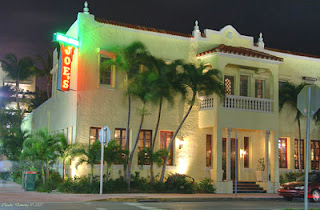And that means: STONE CRABS. Anyone who has been to Miami Beach knows Joe's. It's been renovated and is a lot bigger than the old days. Back then you waited two hours stuffed into a narrow bar. Now you wait maybe an hour in a couple of anterooms and a bar. But if you go all the time, you get in right away. You have to know the trick.
Joe's has a little takeaway cafe now. I recommend you try it for lunch when things aren't as insane. Stone crabs are supposedly eco-friendly, because the crab grows another claw. I'm not positive this is the case and anyway it must hurt the crab to have his arm torn off, but please: they are divine and I don't want to think about it.
Since returning from Miami I've hit the ground running. Along with Erin Elder I'm co-curating an exhibition called "All the News That's Fit to Print," art that uses the New York Times, at the Center for Contemporary Art here. The artists use the newspaper in varied ways. Some use the paper itself for sculptural and wall based works, like I do. One artist whose work I recently discovered is Elissa Levy, from Brooklyn. Here is one of her works that will be in the show, "Expected to Rise."
Other artists highlight and collect bits of content from the paper- here is a work by Pat Boas, of Portland, Oregon, in which she has traced heads from photos on the front page, each drawing consisting of tracings from a full month, with a total of 12 drawings in the series, representing one year:
Everyone bemoans the sad fate of daily newspapers. With Jeff Bezos buying the Washington Post, it should be interesting to see what new ideas he comes up with. I know the Times has invested in more multi-media reporting, trying to keep up the subscriber base. Personally, I still read the print version of the Times every day and have been for maybe forty years, but I like to read it online occasionally when one of those multi-media stories runs. There was recently a series on a homeless child in New York that was heartbreaking- what is now referred to as "long form" journalism at its best in my opinion. To be continued. Meanwhile, the front page with its compelling above the fold photograph continues my morning ritual.
















